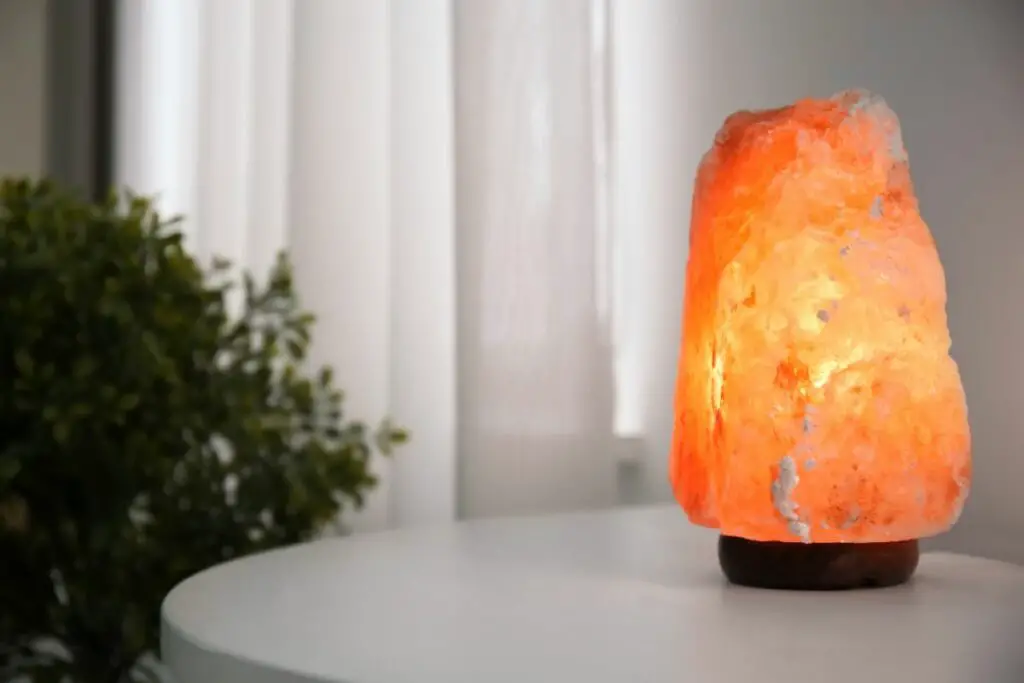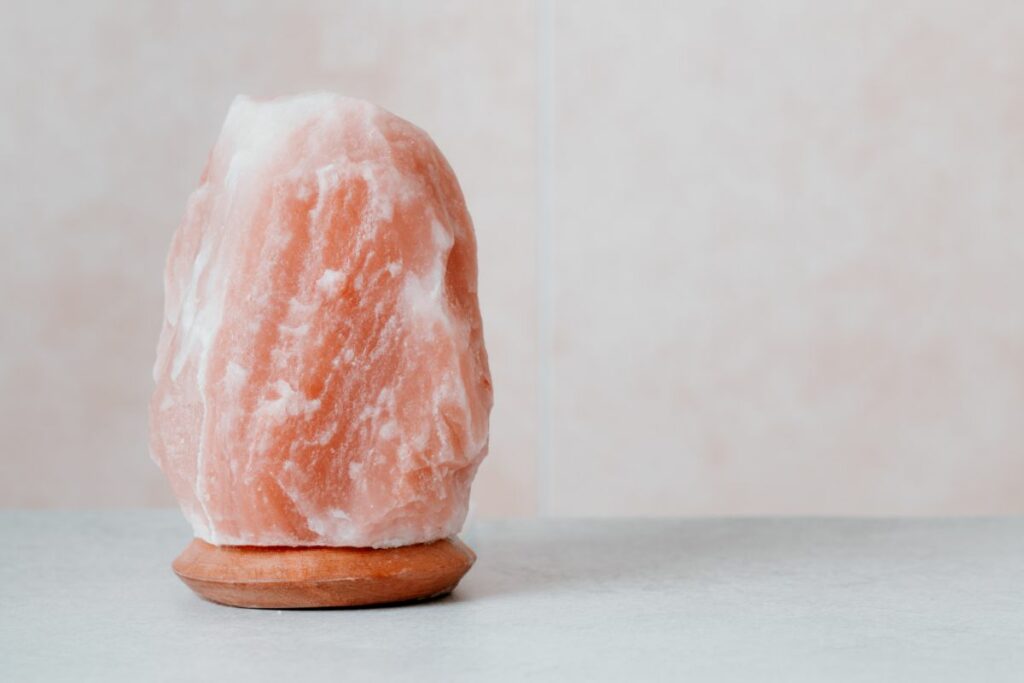Have you been swept along in the Himalayan salt lamp trend yet? It hooked me a few years ago and now I have lamps everywhere!
Himalayan salt lamps are beautiful decorative pieces, but they are also favoured for their potential health benefits such as air purification and mood enhancement.

However, as natural and somewhat delicate items, they require a bit of special care to keep them shining brightly.
In this guide, I’ll cover how to clean and maintain your Himalayan salt lamp, and I’ll troubleshoot some common problems too.
Himalayan Salt Lamp: Essential Care Tips
Placement
Location is vital when deciding where to place your salt lamp. Because of its hygroscopic nature—meaning it attracts moisture from the air—it’s best to avoid humid rooms such as bathrooms and kitchens.
Also, keep the lamp away from direct sunlight, as excessive heat can lead to sweating.
Light Bulb
One of the best ways to maintain your salt lamp is by ensuring it is lit regularly. The warmth from the bulb helps to evaporate the moisture that the salt lamp absorbs from the surrounding air.
Remember to use the correct wattage for your lamp; too high a wattage can lead to overheating, while too low might not provide enough heat to evaporate the moisture.
Most Himalayan salt lamps use a bulb between 15 to 25 watts, but always check the manufacturer’s specifications.
How To Clean A Himalayan Salt Lamp
If your Himalayan salt lamp has gathered some dust and needs a bit of sprucing, here’s what you can do:
Materials Needed:
- A soft, dry cloth
- A moist cloth or sponge
- Baking soda (optional)
- A dry towel
- A fan or dry location (optional)
Step 1: Unplug Your Lamp
To begin, always ensure your safety by unplugging the salt lamp. It’s not a good idea to clean an electrical item whilst it’s still connected to a power source. Once unplugged, remove the bulb and set it aside safely.
Step 2: Dusting Off Surface Salt
Start by using a dry, soft cloth to gently dust off any loose salt or debris from the lamp. Himalayan salt lamps are prone to “sweating”, especially in high humidity, which can cause surface salt to crystallise. This process should remove the bulk of any loose salt.
Step 3: Wiping The Lamp
Next, take your moist (not soaking wet) cloth or sponge and gently wipe down the lamp. Remember, salt dissolves in water, so you don’t want to saturate the lamp.
A light moistening will do. This should help remove any dirt or stains that weren’t dislodged during the dusting process.
Step 4: Dealing With Stubborn Stains
If your lamp has stubborn stains that didn’t come off with the moist cloth, you can use a bit of baking soda. Mix a small amount with water to create a paste, and gently rub this onto the stain. After a few moments, wipe it away with your moist cloth.
Step 5: Drying The Lamp
Once you’ve finished wiping down your lamp, take your dry towel and carefully dry it off. Because of the lamp’s nature, it’s essential to ensure it’s completely dry before you use it again. Any residual moisture could potentially cause electrical issues.
Step 6: Air Drying
For an extra layer of safety, and to ensure all moisture is completely gone, consider letting your salt lamp air-dry for a few hours or overnight. This can be done in a well-ventilated or sunny spot, or in front of a fan.
Step 7: Reassemble And Test
When you’re confident that your lamp is dry, you can reassemble it by putting the bulb back in and plugging it into the mains. Turn on the lamp to make sure everything is working correctly.
Your Himalayan salt lamp should now be clean, bright, and ready to add its calming ambience to your space once more.

Himalayan Salt Lamp Troubleshooting
One of the most commonly asked questions regarding Himalayan salt lamps is why they sometimes appear wet or sweaty. This ‘sweating’ is actually a result of the hygroscopic properties of salt.
Salt naturally attracts water molecules from the surrounding air. The salt lamp attracts this moisture and it then settles on the surface, giving it a wet appearance.
However, this should not cause you too much concern. A well-maintained and regularly lit Himalayan salt lamp can keep this sweating under control by evaporating the moisture it absorbs.
Remember, it’s perfectly normal for your lamp to sweat, especially during more humid periods.
If your lamp appears excessively wet or is leaking water, it may be due to high humidity in the room or a lack of regular lighting. To rectify this, relocate the lamp to a less humid room and ensure that it’s lit for enough time each day.
If your lamp remains wet despite these efforts, consider using a dehumidifier to reduce the amount of moisture in the air.
In the worst-case scenario, if the lamp has absorbed too much water and starts to dissolve, unplug it and move it to a dry, warm room. Leave it off until it’s completely dry. If the problem persists, it may be necessary to seek professional advice.
This question is very much linked to the above about why your Himalayan salt lamp might be sweating.
When the lamp is switched off for extended periods, and thus not warm enough to evaporate this moisture attracted by the salty surface, the water can actually dissolve some of the salt on the lamp’s surface.
When the water eventually evaporates, it leaves behind a crystallised salt residue, which can give the lamp a whitish appearance. This is a common occurrence and not necessarily a sign of damage or a decrease in the lamp’s effectiveness.
There are a few strategies to manage this:
Keep Your Lamp On: Try to leave your lamp switched on as much as possible. The heat from the bulb will help evaporate the moisture and stop the salt from dissolving.
Use in Dry Areas: Try to keep your lamp in a dry area of your home, away from sources of high humidity like bathrooms and kitchens.
Light Bulb Strength: Make sure you’re using the correct wattage for the size of your lamp. A bulb that’s too weak may not produce enough heat to evaporate the moisture. Generally, a 15-watt bulb is suitable for a smaller lamp (up to 5kg), whereas larger lamps may require a 25-40 watt bulb.
Use a Cloth Cover: When the lamp is not in use, consider lightly covering it with a cloth or placing it in a closed bag to protect it from ambient moisture.
Regular Cleaning: Regularly cleaning your salt lamp, as per the steps described in the previous article, can help maintain its appearance and functionality.
Remember, a white crust doesn’t mean your lamp is losing its effectiveness or value.
Final Thoughts
A Himalayan salt lamp is a unique piece of home décor with potential health benefits. As a natural piece of rock salt, it requires careful maintenance to ensure it remains both visually pleasing and functionally effective.
Proper placement, the right bulb usage, gentle cleaning, and understanding its hygroscopic nature all play crucial roles in looking after your salt lamp.
A well-maintained Himalayan salt lamp can be a fascinating conversation starter, a calming ambient light, and a potential source of numerous health benefits for many years.
- Pegasus Symbolism: Understanding The Spiritual Meaning And Dream Meaning Of Pegasus - November 5, 2023
- 50 Beautiful Moonstone Affirmations To Try - November 5, 2023
- The 6 Best Samhain Crystals To Work With This Spooky Season - October 23, 2023






